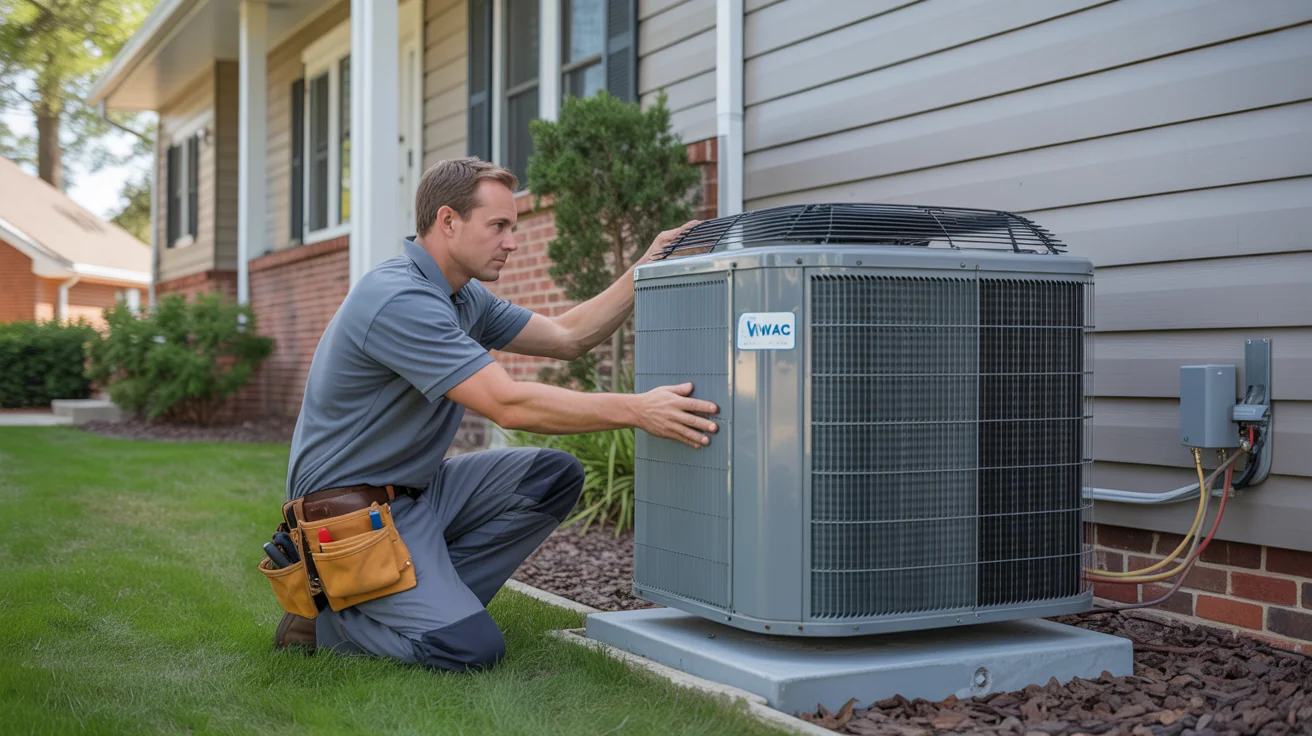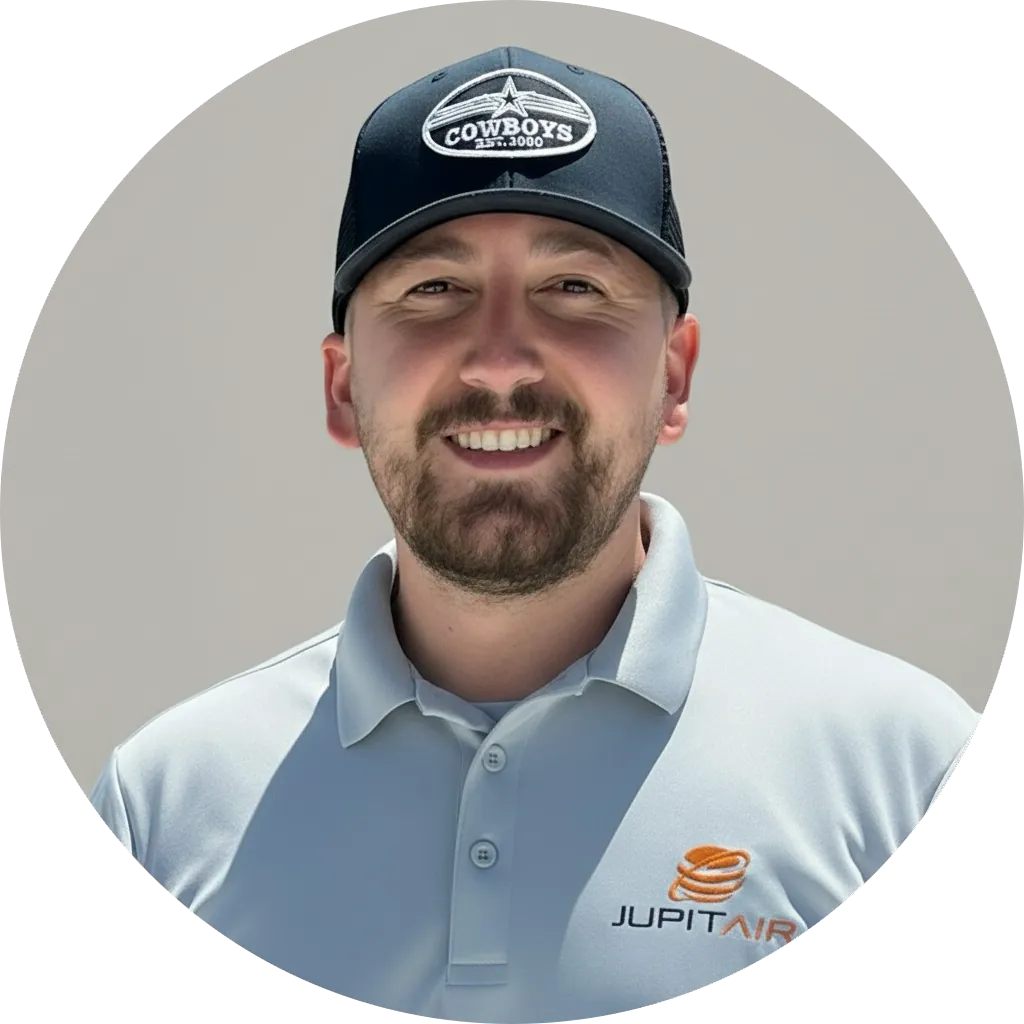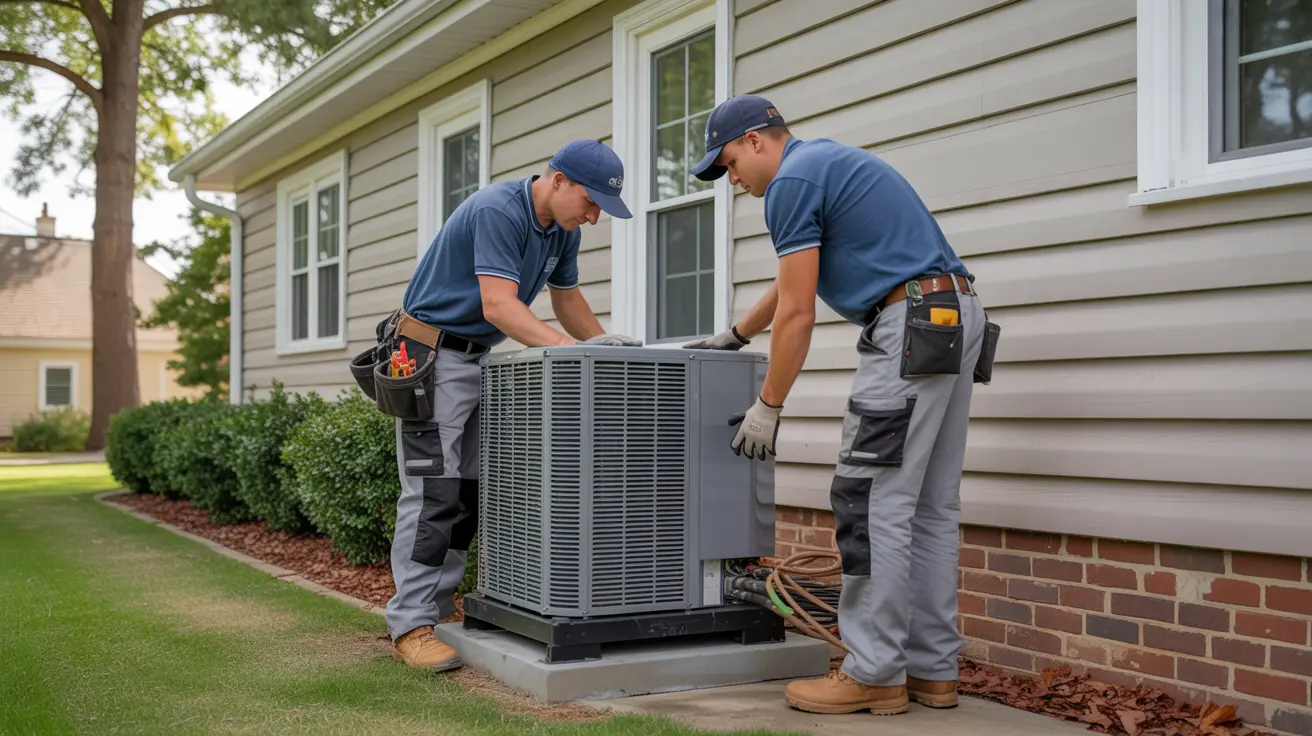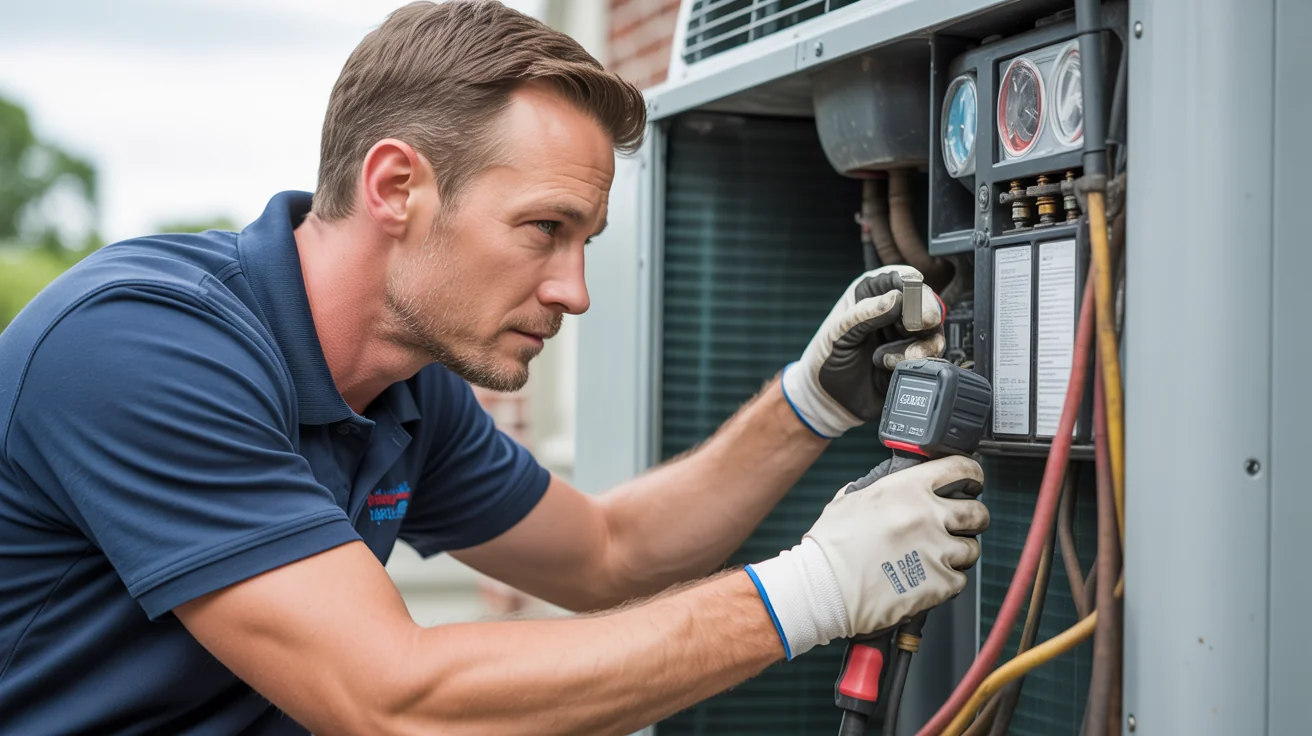North Texas Weather-Specific HVAC Strategies: Managing Extreme Conditions Year-Round
Expert HVAC strategies for North Texas extreme weather conditions. Comprehensive guide to managing heat waves, ice storms, severe weather, and rapid temperature changes for optimal system performance.

- Mother Nature Declared War on North Texas HVAC Systems
- Rapid Temperature Change Management
- Temperature Swing Challenges in North Texas
- System Adaptation Strategies
- Humidity Management in Extreme Weather
- North Texas Humidity Challenges
- Weather-Specific Humidity Control
- Regional Weather Considerations
+ 11 more sections below...
- Mother Nature Declared War on North Texas HVAC Systems
- Rapid Temperature Change Management
- Temperature Swing Challenges in North Texas
- System Adaptation Strategies
- Humidity Management in Extreme Weather
- North Texas Humidity Challenges
- Weather-Specific Humidity Control
- Regional Weather Considerations
+ 11 more sections below...
Mother Nature Declared War on North Texas HVAC Systems
You know what I learned after 15 years battling Texas weather? Mother Nature here plays for keeps. I’ve crawled under houses during tornado warnings, serviced rooftop units in 108°F heat domes that made the metal too hot to touch, and watched outdoor units turn into ice sculptures during February freezes.
Last February, I watched the temperature drop from 75°F to 12°F in eight hours. My phone rang 47 times that night. Forty-seven families whose heating systems couldn’t handle the thermal shock.
Here’s the truth real estate agents don’t mention when you move here: your HVAC system will work three times harder than it would in Denver or Seattle. I’ve seen more equipment failures during our first 100°F day of summer than most techs in moderate climates see all year.
After diagnosing thousands of weather-related disasters, I know exactly what works and what doesn’t when Texas weather gets vicious. These strategies actually keep systems running when Mother Nature tries her best to break them.
Every HVAC tech in North Texas has war stories about the weather. Mine started during my second summer on the job, when we hit 45 consecutive days over 100°F. I watched perfectly good systems cook themselves to death because they couldn’t catch a break.
Summer heat here isn’t just hot - it’s relentless. When you’re working on a rooftop unit in Plano and the metal is literally too hot to touch, you understand why equipment fails. The pavement radiates heat, the buildings store it, and by afternoon, downtown Dallas runs 12 degrees hotter than the suburbs. I’ve measured supply air temperatures that should be 55°F coming out at 68°F because the system just can’t keep up.
Then there’s storm season. I’ve replaced more outdoor units destroyed by hail than I care to count. Last spring in McKinney, I watched golf ball-sized hail punch holes through condenser coils like a machine gun. The sound was unforgettable.
Winter brings different challenges. During the 2021 freeze, I saw heat pumps encased in two inches of ice, looking like frozen waterfalls. The expansion and contraction from freeze-thaw cycles literally cracked heat exchangers. I spent that week helping families whose heating systems failed when they needed them most.
When I see a heat dome building on the weather radar, I go into battle mode. These aren’t your typical hot days - we’re talking about atmospheric prison cells where the heat has nowhere to escape.
I learned my heat wave preparation from emergency calls during the 2022 heat dome. Watched too many systems fail because nobody prepared them for sustained abuse. Now I tell customers: when meteorologists start using words like “dangerous” and “life-threatening,” your AC needs help.
Here’s what I actually do when a heat wave warning hits:
First, I check the refrigerant. Systems running even slightly low will struggle when outdoor temps hit 105°F. I use my digital manifolds to verify pressures match manufacturer specs exactly. During extreme heat, there’s zero margin for error.
Then I clean those condenser coils thoroughly. Dirty coils are like wearing a winter coat in a sauna - they trap heat when the system desperately needs to reject it. I’ve seen 20-degree temperature differences between clean and dirty coils.
Smart homeowners pre-cool their houses while it’s still manageable. Drop that thermostat to 72°F at 6 AM, before the sun starts baking everything. Your system can actually achieve that temperature in the morning. By 3 PM, it might struggle to hold 78°F.
Living through a heat wave with an HVAC system is like managing a marathon runner. You’ve got to pace it or it’ll collapse before the finish line.
Morning is your golden window. While most people sleep in, smart homeowners are running their AC hard from 5-10 AM. I tell customers to get aggressive with cooling while outdoor temps are still in the 80s. Your system will thank you later when it’s struggling against 108°F heat.
Once that Texas sun starts cooking everything, your strategy changes completely. I’ve learned not to fight physics. When it’s 105°F outside and your AC has been running nonstop for six hours, let the indoor temperature drift to 78-80°F. Use ceiling fans - they make 78°F feel like 75°F through air movement.
People panic when they see their system running continuously, but during extreme heat, that’s actually normal. What worries me is when I see units short-cycling or shutting down on safety switches. That means the system is overwhelmed.
I check on my most vulnerable customers during heat waves. Last summer in Frisco, I found Mrs. Johnson’s unit had stopped cooling because cottonwood seeds had clogged her condenser coils. Fifteen minutes of cleaning, and she was back in business. During heat waves, equipment needs daily attention.
When systems fail during heat waves, it becomes a medical emergency, not just a comfort issue. I’ve seen indoor temperatures hit 95°F within two hours of AC failure. That’s dangerous territory, especially for elderly folks and kids.
My emergency protocol starts with safety. If there’s any smell of gas or signs of electrical problems, everyone evacuates immediately. But if it’s a mechanical failure, we go into damage control mode.
I carry portable AC units for emergencies like this. Not the cheap ones from big box stores - commercial units that can actually cool a room. While I’m diagnosing the problem, at least people have some relief.
During the 2022 heat dome, I worked 16-hour days because failures weren’t just inconveniences - they were life-threatening. I remember one call in Allen where an elderly couple’s compressor had seized. Indoor temp was 92°F and climbing. I set up portable cooling in their bedroom and called their family. Sometimes you’re part HVAC tech, part EMT.
Refrigerant leaks are the worst during heat waves. The system might limp along for a while, then suddenly lose all cooling when you need it most. Compressor failures are expensive but at least decisive - you know exactly what needs fixing.
Storm season in Texas is like playing Russian roulette with your HVAC equipment. I’ve seen perfectly good systems destroyed in minutes by hail that sounded like machine gun fire on metal rooftops.
March through June is the main event, but storms can surprise you. Two years ago, a November supercell dropped softball-sized hail in Prosper that destroyed 40% of the outdoor units in one neighborhood. Insurance companies had adjusters flying in from other states just to handle the claims.
When I see severe weather warnings, I start making calls. Not just to schedule repairs afterward, but to help customers protect their equipment beforehand. Prevention saves thousands.
First thing I tell people: walk around your outdoor unit and remove anything that could become a missile. I’ve seen patio furniture punch holes through condenser coils. Garden tools, kids’ toys, even decorative rocks become dangerous projectiles in 80-mph winds.
For customers in notorious hail corridors, I keep plywood sheets ready for equipment protection. It looks ridiculous covering your AC with plywood, but replacement condensers cost $2,500. Plywood costs $40.
Surge protection is non-negotiable. I learned this the hard way during my early years when lightning took out five systems in one storm. Now every customer gets whole-house surge protection. It’s cheaper than replacing circuit boards and compressors.
When storm cells are approaching, I tell customers to shut down their HVAC systems completely. Not just the thermostat - flip the breakers. I’ve seen too many systems fried by power surges during storms.
One night during a severe weather outbreak, I was monitoring radar between emergency calls. Watched a supercell tear through Frisco with 75-mph winds. The power flickered six times in ten minutes. Every flicker was a potential surge that could destroy sensitive electronics.
Stay inside and away from windows during active storms. Your outdoor unit can handle wind and rain, but you can’t. I’ve been caught outside during severe weather more times than I care to admit, and it’s terrifying.
Document everything with photos if you can do so safely. Insurance companies want proof of damage, and memories fade. Time-stamp photos showing equipment condition before and after storms.
The hours after severe storms are the most dangerous for HVAC systems and homeowners. I’ve responded to post-storm emergencies where people were standing in flooded basements next to energized electrical panels. Safety first, always.
My post-storm inspection routine starts from a distance. I look for obvious hazards: downed power lines, gas leaks, structural damage that could collapse on equipment. If anything looks dangerous, I call the appropriate utility company before getting closer.
Hail damage is usually obvious - dented cabinets and chewed-up condenser coils that look like Swiss cheese. But wind damage can be subtle. I check that units are still level and properly secured. A shifted unit might work temporarily but cause expensive problems later.
Water damage is the sneakiest. During Hurricane Harvey’s aftermath, I found systems that looked fine externally but had flooded control boards. Electronics and water don’t mix. Even if components dry out, corrosion starts immediately.
I take detailed photos of all damage for insurance claims. Insurance adjusters see thousands of claims after major storms, and clear documentation helps customers get fair settlements. I’ve testified for customers when insurance companies tried to deny legitimate claims.
After severe storms, my phone doesn’t stop ringing. Everyone needs service immediately, but I triage calls based on safety and urgent needs. Gas leaks and electrical hazards get immediate response. Comfort issues wait.
Working with insurance adjusters after storms has taught me to speak their language. They need specific information: equipment age, damage extent, repair versus replacement costs. Good documentation speeds up claims and gets customers back to comfort faster.
I’ve learned to coordinate with restoration companies during major storm recovery. Water damage requires specialists, and HVAC work often can’t start until water extraction and structural drying are complete. Patience saves money and prevents bigger problems.
Ice storms create a special kind of HVAC hell. I’ll never forget February 2021 when ice coated everything in a half-inch shell. Heat pumps looked like frozen waterfalls, completely encased in ice. The defrost systems couldn’t keep up.
What most people don’t realize is that ice loading can actually bend and crack refrigerant lines. I’ve found pinhole leaks in copper tubing that developed during freeze-thaw cycles. The metal contracts and expands beyond its limits, creating failures that show up weeks later when the weather warms.
Heat pumps are particularly vulnerable. Their defrost cycle relies on reversing refrigeration to melt ice off coils, but when ice builds up faster than the system can melt it, the whole process fails. I’ve seen units so iced over they couldn’t move air at all.
When I see freeze warnings, I start preparing for the worst. Not because I’m pessimistic, but because I’ve lived through enough Texas ice storms to know they can paralyze everything.
First rule: never let your house get below 55°F inside, even if you’re trying to save money. Frozen pipes cost way more than heating bills. I’ve seen $15,000 in water damage from burst pipes that could have been prevented with a $200 heating bill.
I insulate every exposed pipe I can find - especially in crawl spaces and unheated areas. Those cheap foam pipe sleeves from the hardware store are worth their weight in gold during freezes.
During the big freeze of 2021, I made sure my own family was prepared. We moved mattresses into one room, stocked up on blankets and batteries, and identified which neighbors had generators. Community matters when infrastructure fails.
I keep a list of warming centers on my phone and share it with customers. When heating systems fail during ice storms, people need safe places to go. Pride doesn’t keep you warm.
During active freeze events, I become part HVAC tech, part survival instructor. The 2021 freeze taught all of us harsh lessons about winter preparedness in Texas.
The biggest mistake people make is turning off their heat to save money when power grids are stressed. I understand the impulse - your electric bill is scary during ice storms. But frozen pipes will bankrupt you faster than high heating bills.
I monitor my heat pump customers extra closely during freezes. Heat pumps work harder as temperatures drop, and their defrost cycles become critical. I tell customers not to panic when they see steam and frost during defrost - it’s the system doing its job.
But when ice builds up faster than defrost can handle, heat pumps struggle. I’ve seen units ice over completely, blocking all airflow. At that point, auxiliary heat carries the load until conditions improve.
Space heater safety becomes life-or-death important during extended freezes. I’ve responded to house fires caused by improper space heater use. Keep them away from combustible materials, never use extension cords, and maintain ventilation for fuel-burning units.
The thaw after a hard freeze is almost more dangerous than the freeze itself. That’s when frozen pipes burst and hidden damage reveals itself.
I warn customers to check for water leaks as temperatures rise. Pipes that cracked during the freeze don’t always leak immediately. When ice melts and water pressure returns, that’s when you discover problems.
I’ve found cracked heat exchangers that developed hairline fractures during freeze-thaw cycles. These aren’t immediately obvious but create dangerous carbon monoxide risks. Any heating system that was stressed during extreme cold needs professional inspection.
After the 2021 freeze, I spent weeks diagnosing mysterious system failures that traced back to freeze damage. Refrigerant leaks, failed electrical components, damaged ductwork - the full scope of damage often isn’t apparent until systems are thoroughly tested.
Rapid Temperature Change Management
Temperature Swing Challenges in North Texas
Extreme Temperature Variations: Extreme Temperature Variations:
Daily swings bring 40-50°F differences between morning and afternoon temperatures that challenge system adaptation. Frontal passages create temperature drops of 30-40°F in 2-3 hours that stress equipment beyond normal operating parameters. Seasonal transitions produce 70°F+ changes over 48-hour periods that require flexible system response and programming. Urban vs. rural variations show temperature differences across the metro area that affect system sizing and operation needs.
System Adaptation Strategies
Programming for Temperature Swings: Traditional thermostat programming fails during rapid temperature changes, requiring adaptive strategies.
Adaptive Programming Techniques: Adaptive Programming Techniques:
Wide temperature deadbands (3-5°F) reduce system cycling during transitions and prevent equipment from overworking during unstable conditions. Weather-responsive programming adjusts based on outdoor conditions to optimize system response to changing weather patterns. Gradual setpoint changes rather than dramatic adjustments prevent system shock and maintain efficient operation during temperature swings. System staging optimization ensures efficient response to rapid changes while protecting equipment from stress and premature failure.
Equipment Considerations for Temperature Swings: Equipment Considerations for Temperature Swings:
Variable speed systems adapt better to changing conditions than single-speed equipment by providing precise capacity modulation during temperature transitions. Two-stage equipment provides better response to moderate temperature changes with improved efficiency compared to single-stage systems. Heat pump systems require careful auxiliary heat management during swings to maintain efficiency while providing adequate heating capacity. Zoning systems allow targeted response to varying conditions throughout home by independently controlling different areas based on specific needs.
Humidity Management in Extreme Weather
North Texas Humidity Challenges
Seasonal Humidity Variations: Seasonal Humidity Variations:
Summer brings high humidity (60-80%) that increases cooling loads and discomfort, requiring systems to work harder for the same comfort level. Winter creates low humidity (15-25%) that causes comfort problems and static electricity issues throughout the home. Transition seasons produce rapid humidity changes that stress systems and occupants with constantly shifting moisture levels. Storm periods bring extreme humidity spikes during weather events that overwhelm normal humidity control systems.
Weather-Specific Humidity Control
High Humidity Management (Summer storms, Gulf moisture): High Humidity Management (Summer storms, Gulf moisture):
Enhanced dehumidification through longer system runtime helps remove excess moisture during high humidity periods when normal cycling isn’t sufficient. Whole-home dehumidifiers provide independent humidity control that works alongside HVAC systems for optimal moisture management. Improved air sealing prevents humid outdoor air infiltration that adds unwanted moisture to conditioned spaces. Exhaust fan usage removes indoor humidity sources like cooking and bathing moisture before it affects overall home comfort.
Low Humidity Management (Winter heating, dry air masses): Whole-home humidifiers to maintain 30-40% humidity. System runtime optimization to prevent over-drying. Air sealing to retain conditioned air and humidity. Indoor plants and water features for natural humidity addition.
Regional Weather Considerations
Dallas-Fort Worth Metro Weather Patterns
Urban Heat Island Effects: Enhanced heat stress - cities 8-15°f hotter than suburbs. Delayed cooling - urban areas cool more slowly in evenings. Storm intensity changes - urban effects on storm development and intensity. Air quality impacts - pollution concentrating during stagnant weather.
Metro-Specific HVAC Strategies: Enhanced cooling capacity calculations for urban heat effects. Extended cooling seasons requiring longer operation periods. Air quality management during high pollution weather events. Peak demand management during grid stress periods.
Suburban and Rural North Texas Considerations
Open Area Weather Exposure: Higher wind exposure affecting outdoor equipment. Greater temperature extremes without urban moderation effects. Storm damage risk from less protected equipment locations. Backup power needs due to longer utility restoration times.
Rural-Specific Strategies: Enhanced equipment protection from wind and weather exposure. Backup power systems for extended outage protection. Propane system considerations for areas without natural gas. Well water protection during freeze events.
Emergency Preparedness and Response Planning
Weather Emergency Kit for HVAC Systems
Essential Emergency Supplies: Portable heating sources (safe space heaters, blankets, sleeping bags). Portable cooling options (battery-powered fans, cooling towels, ice). Backup power (generator, battery packs, flashlights). Communication tools (weather radio, cell phone chargers). Emergency contacts (hvac service, utilities, insurance).
System-Specific Emergency Supplies: Spare filters for extended outages and high-debris periods. Basic tools for minor repairs and adjustments. Refrigerant leak detector for spoting system problems. Digital thermometer for monitoring indoor temperatures. Camera for documenting weather damage for insurance.
Family Emergency Plan for HVAC Failures
Extreme Heat Emergency Plan: Cooling center locations and transportation arrangements. Hotel reservations for extended outages during heat waves. Health monitoring protocols for heat-related illness. Pet protection plans for extreme heat conditions.
Extreme Cold Emergency Plan: Warming center locations and backup heating sources. Pipe protection procedures and emergency shut-off locations. Carbon monoxide prevention when using alternative heating. Emergency supply distribution and family communication.
Professional Weather Response Services
Emergency Service Priorities
For immediate assistance, see our Emergency Service service.
Weather Emergency Service Categories:
Immediate Response (2-4 hours): Safety hazards - gas leaks, electrical dangers, carbon monoxide risks. Complete system failures during extreme weather health risks. Storm damage creating immediate danger to persons or property.
Priority Service (Same day): Partial system failures during extreme weather. Weather damage assessment for insurance and repair planning. Emergency repairs to restore basic heating or cooling.
Scheduled Service (24-48 hours): Post-weather system inspection and performance testing. Preventive repairs identified during emergency assessment. System optimization for continued extreme weather resilience.
Weather-Specific Service Programs
Storm Season Preparation Service: Pre-season equipment inspection and storm preparation. Surge protection installation and electrical system protection. Emergency service priority during storm events. Post-storm damage assessment and insurance coordination.
Heat Wave Preparation Service: Pre-summer system optimization for extreme heat performance. Emergency service priority during heat warnings. Performance monitoring during extended heat periods. Recovery service after extreme heat events.
Cost Management During Weather Extremes
Weather-Related Cost Planning
Emergency Service Cost Management: Service contracts providing priority service and discounted emergency rates. Preventive maintenance reducing emergency service needs. Insurance coordination for weather-related repairs. Energy cost management during extreme weather utility pricing.
Investment Priorities for Weather Resilience:
- Surge protection: $300-800 investment preventing $2,000-8,000 equipment damage
- Backup power: $2,000-8,000 investment providing comfort and safety during outages
- Enhanced equipment: $1,000-3,000 premium for weather-resistant equipment
- Emergency supplies: $200-500 investment in comfort and safety during extreme events
Frequently Asked Questions
Q: How should I prepare my HVAC system for severe weather? A: Secure outdoor equipment, install surge protection, check system operation, and have emergency heating/cooling plans. Professional pre-season preparation is recommended.
Q: What should I do if my AC fails during a heat wave? A: Ensure family safety first with fans, hydration, and cooling centers. Contact emergency HVAC service immediately. Consider hotel accommodation for vulnerable family members.
Q: Is it safe to run my HVAC during severe storms? A: Turn off HVAC systems before storms arrive to prevent surge damage. Resume operation after storms pass and electrical safety is verified.
Q: How can I protect my heating system during ice storms? A: Maintain minimum 55°F indoor temperature, insulate exposed pipes, make sure adequate fuel supply, and have backup heating plans ready.
Q: What weather conditions require emergency HVAC service? A: Complete system failures during extreme temperatures, safety hazards (gas leaks, electrical), and significant weather damage to equipment require immediate professional attention.
Q: How much does weather damage typically cost to repair? A: Minor repairs: $200-800, Major repairs: $1,500-5,000, Complete replacement: $5,000-15,000. Proper preparation and insurance significantly reduce out-of-pocket costs.
After 15 years battling Texas weather alongside HVAC systems, I’ve learned that preparation prevents most disasters. The customers who fare best during extreme weather aren’t the ones with the most expensive equipment - they’re the ones who prepare.
Weather doesn’t wait for convenient timing. Heat domes build over weekends. Ice storms hit during holidays. Severe weather arrives at 2 AM. Your HVAC system needs to be ready for whatever Mother Nature delivers.
I’ve seen too many preventable failures that left families in danger during extreme weather. Don’t gamble with your comfort and safety. Professional preparation and emergency planning make all the difference.
When weather gets extreme, we’re ready: Call (940) 390-5676 for immediate weather emergency response. Available 24/7 during heat waves, storms, and freeze events. 2-hour guaranteed response during weather emergencies. Complete weather preparation and system protection services.
During major weather events, we prioritize safety first, then comfort. Heat wave emergency response focuses on life-threatening cooling failures. Storm damage assessment starts with safety hazards. Freeze protection prevents both comfort loss and property damage.
Maintenance plan customers get priority service during weather emergencies because their systems are already prepared for extreme conditions.
After working through countless heat waves, storms, and freezes across North Texas, I know one thing for certain: weather-prepared HVAC systems keep families safe and comfortable when conditions get dangerous. Don’t wait for the next extreme weather event to test your system’s limits.
Jupitair HVAC - Your North Texas weather survival partner since 2008. We’ve seen it all, fixed it all, and prepared for it all. Licensed & Insured.
Need Professional HVAC Service?
Our certified technicians are ready to help with any HVAC needs in North Texas




